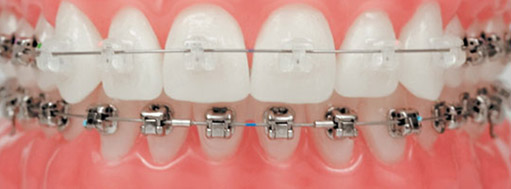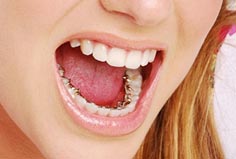Types of Braces
Traditional Metal Braces
Traditional metal braces are the most common type of braces and are more comfortable today than ever before. Made of high-grade stainless steel, metal braces straighten your teeth using metal brackets and archwires. With metal braces, you have the option of adding colored elastics (rubber bands) for a more unique and colorful smile.

Clear (Ceramic) Braces
Ceramic braces are made of clear materials and are therefore less visible on your teeth than metal braces. For this reason, ceramic braces are used mainly on older teenagers and adult patients who have cosmetic concerns. While they are visually less prominent, they do require more attention to oral hygiene as ceramic braces are larger and are more brittle than their metal counterparts. For these reasons, ceramic braces tend to be used more on upper front teeth than on lower teeth.


Clear Aligners
Clear aligners are a series of invisible, removable, and comfortable acrylic trays that straighten your teeth like braces. Not only are the aligners invisible, they are removable, so you can eat and drink what you want while in treatment, plus brushing and flossing are less of a hassle. The aligners are comfortable and have no metal to cause mouth abrasions during treatment.

Self-Ligating Braces
Self-ligating braces are made from the same materials as traditional braces. However, self-ligating braces do not require the use of elastics, meaning fewer appointments and less friction being placed on the tooth. Self-ligating braces come with traditional metal, ceramic, or clear brackets. They are the same size as metal braces, but use a specialized clip in place of elastics to help the archwire guide teeth into place. The clip helps reduce the amount of pressure being placed on the tooth, and requires fewer adjustments because there are no elastics to replace.

Lingual Braces
Today, there are metal braces that can be placed on the "tongue side" or lingual of every tooth. Known as lingual braces, these appliances are completely hidden from the outside world. Lingual braces are a great choice for teens and adults who are concerned about wearing braces that are obvious to their friends, families, work colleagues or schoolmates. Musicians who play wind instruments, adult professionals, and people who play contact sports are all ideal candidates.
While these braces work in the same way as the metal or ceramic braces affixed to the front of your teeth, they can only be spotted on close inspection during such times as when your mouth is wide open. The process for lingual braces involves taking an impression of the teeth, which is then sent to a dental laboratory and used to create customized brackets. Your choice of brand depends upon the orthodontist and her recommendation, as well as your preference. Some of the most popular brands are: Incognito, iBraces, In-Ovation, STb Light, Suresmile, Lingual QT, Harmony.


Not All Orthodontists Offer Lingual Braces
Because the pressure that moves your teeth into place occurs on the inside of your teeth rather than the outside, training and technical expertise are needed. Your orthodontist must understand the types of movement that will occur and how they may differ from conventional braces. Dr. Lorenzo prides herself in being one of the few local orthodontists certified to treat patients with lingual braces.

